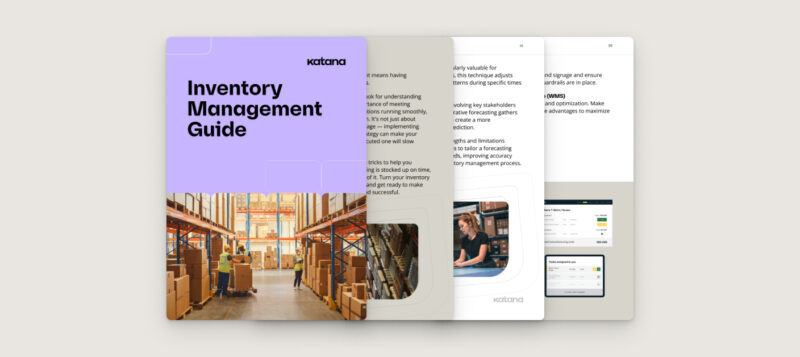Shopify inventory forecasting: The crystal ball you can master

Ioana Neamt

Let’s say you’re on vacation. You wake up, the sun is up, you can hear the waves crashing through the open balcony door, and a slight soothing breeze is blowing in your face. It’s magical. You make yourself representable and head down to the restaurant for your pre-paid breakfast. To your dismay, most of the serving platters are empty. You manage to scare up a couple of bread buns, two slices of ham, and a pile of artistically shaped cucumber slices.
This is the kind of thing that can ruin a good chunk of your morning, regardless of how beautiful everything else was before that. But what went wrong?
This article tackles the root cause of such problems with a focus on Shopify. We take a look at what is Shopify inventory forecasting, its benefits, and tools to help you generate them.

What is Shopify inventory forecasting?
Shopify inventory forecasting is a process used by businesses operating on the Shopify platform to predict future stock requirements based on historical sales data, trends, and patterns. This forecasting helps Shopify store owners make informed decisions about how much inventory to purchase and maintain to meet customer demand without overstocking or understocking. Effective inventory forecasting is crucial for managing cash flow, maximizing sales, and improving customer satisfaction.
Why is stock forecasting important for your business?
Stock forecasting is about predicting demand to balance numbers:
- Inventory in
- Inventory out
- Smart budgeting
- Production planning
- Ordering materials
Running a tight ship means getting that balance as close as possible, as it can certainly make a difference to the quality of the relationship you have with your clients, as well as to the sustainability and profitability of your business.

Download the ultimate guide to inventory management
A comprehensive ebook with everything you need to know about inventory management.

What are the main benefits of Shopify inventory forecasting?
The full array of benefits your ecommerce business gets from good stock forecasting depends on many aspects that can be particular to your trade, your location, your stock, and much more. But it’s safe to say that the following three examples apply to pretty much any business selling products:
- Reduce stockouts — Perhaps the first thing you notice with good stock forecasting is that you never have to say, “We’re out of what you’re looking for.” If you predict demand for your products well enough, you will always have inventory on hand to meet the needs of your customers.
- Reduce overstocking — Rightsizing your stock also works in the opposite direction, where correctly anticipating demand means you do not end up carrying excess inventory.
- Optimize cash flow — Avoiding costs related to excess stock storage is just one way to optimize your finances with forecasting. Less money tied up in unnecessary inventory means more money available for investment in other aspects of growth for your business, such as optimizing efficiency throughout your supply chain or more confident procurement and production planning.
What are the most common challenges of Shopify stock forecasting?
While you might have quite particular prediction challenges, depending on what Shopify store offers, there are a few universally challenging factors that all businesses should keep in mind:
- The unpredictable — While most seasonal trends can be anticipated pretty accurately, it is important to acknowledge that there will, occasionally, be things that you cannot realistically see coming. Take the most recent lessons from the pandemic that uprooted the world at the start of 2020 — although there are some general guidelines for even the most unlikely of scenarios, nobody could predict with any level of accuracy just how much demand there would very suddenly be for certain products, or how long that demand would last.
- Data quality — Provided there are no global crises to throw you off, most of the time, you can get a pretty accurate and reliable forecast, as long as you are working with good quality data. If the information you analyze is incomplete, inaccurate, or outdated, the flaws of your forecast will most likely show either as stockouts or as excess inventory.
- The trend trap — Sometimes, a new trend comes along that looks highly promising, that it would take hold and that it’s worth moving mountains to capitalize on it. However, if it’s unlike anything that is reflected in your best forecast data, there is always the risk that novelty is the only actual attraction of this trend and that it will be short-lived.
Are there different types of Shopify inventory forecasting?
Depending on how detailed you want this classification to be, you can slice it in any number of ways. However, there are four general approaches to Shopify stock forecasting that you should start looking at:
- Quantitative forecasting — This data-driven approach predicts future demand using historical sales data from your Shopify store and statistical methods. It typically works best for businesses that have a significant amount of historical information on their products to work with.
- Qualitative forecasting — When historical data is incomplete, limited, or insufficiently reliable for any other reason, this method might work better for you. For instance, if you need to predict demand in a volatile market or for a new product, you’re more likely to rely on expert opinions, subjective judgment, and other relevant approaches that cannot be quantified.
- Graphical forecasting — This method is best used to complement and enhance quantitative and/or qualitative stock forecasting. Graphical representation can help improve communication, spot any errors or inconsistencies more easily, and offer better clarity for decision-making.
- Trend forecasting — Also a data-driven method, this is very similar to quantitative forecasting, but it specifically looks to identify and prepare for long-term trends. Therefore, you would likely not use it to map out any short-term fluctuations.
Need to forecast your Shopify inventory?
Katana connects with Shopify seamlessly and lets you generate forecasts based on accurate sales data.

Three best practices to observe for your Shopify inventory forecasting
It’s good to follow the herd when it comes to observing best practices that were widely tried and tested. While there are no fail-safe promises, it does go a long way in helping you avoid predictable forecasting misses and better positioning your business for growth. Here are three key recommendations to consider:
- Don’t put all your eggs in one basket — Predicting commercial demand is a complex process and, for best results, you need to have an understanding of multiple factors. To that end, one of the top-advised best practices is to not rely on one single forecast method. Rather, understand how each one can work best for your products and with your data, so that you can combine their strengths to your advantage.
- Keep your house in order — The quality of your Shopify inventory forecast depends largely on the quality of the data it is based on. Audit the quality of your data regularly and invest in Shopify integration solutions that can give you a good overview of all your demand drivers.
- Update your forecasts regularly — Change is the only constant and, no matter how stable the business environment feels at any given time, it is in your best interest to not take stability for granted. Update your Shopify inventory forecast at whatever regular interval makes the most sense for your particular products.
Examples of Shopify inventory forecasting software
Ecommerce retailers and other businesses, both big and small, face some of the same challenges and “butterfly effects” that ripple through the local, regional, and global economy. Luckily, there are intuitive tools available to make these hurdles easier to prepare for:
- Katana Cloud Inventory Platform offers seamless integration with Shopify, making it easy for you to manage, track, and forecast your Shopify inventory and orders so that you never miss a delivery and your fulfillment process runs smoothly.
- With Bee Low Stock Alert & Forecast, you can track product levels and replenish when they run too low. You can set both minimum and maximum thresholds that help you prevent both stockouts and overstocking and create forecast reports based on your Shopify sales activity.
- Another example is the aptly named Inventory Planner Forecasting solution for ecommerce and multichannel sellers. This software allows you to run analysis and forecasting in sync with your sales history and can give you replenishment recommendations depending on what additional data you can provide.
Optimize your Shopify stock forecast with Katana
Keep your Shopify store shelves optimally stocked, your clients happy, and your business thriving with Katana Cloud Inventory Platform. Katana gives you the tools to:
- Take charge of your ecommerce inventory with a real-time overview of your orders, inventory tracking, and end-to-end traceability
- Sync and manage multilocation inventory from a single intuitive platform
- Maintain optimal inventory levels, even as your operation scales up, with inventory optimization software designed to streamline your processes
Don’t ruin your customers’ day with empty serving platters or shelves. Request a demo today and see how Katana can ensure you keep your stock levels just right.

Ioana Neamt
Table of contents
Get inventory trends, news, and tips every month
Get visibility over your sales and stock
Wave goodbye to uncertainty with Katana Cloud Inventory — AI-powered for total inventory control